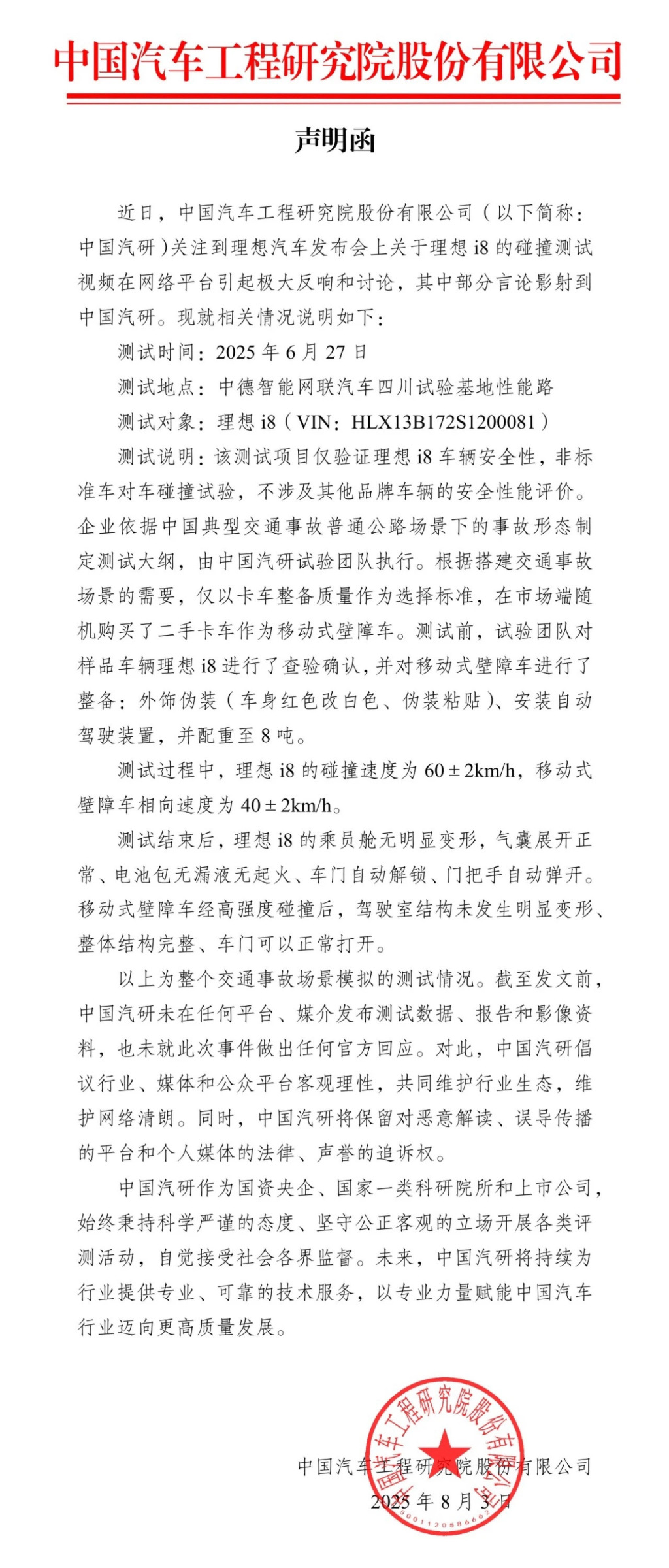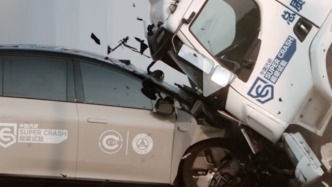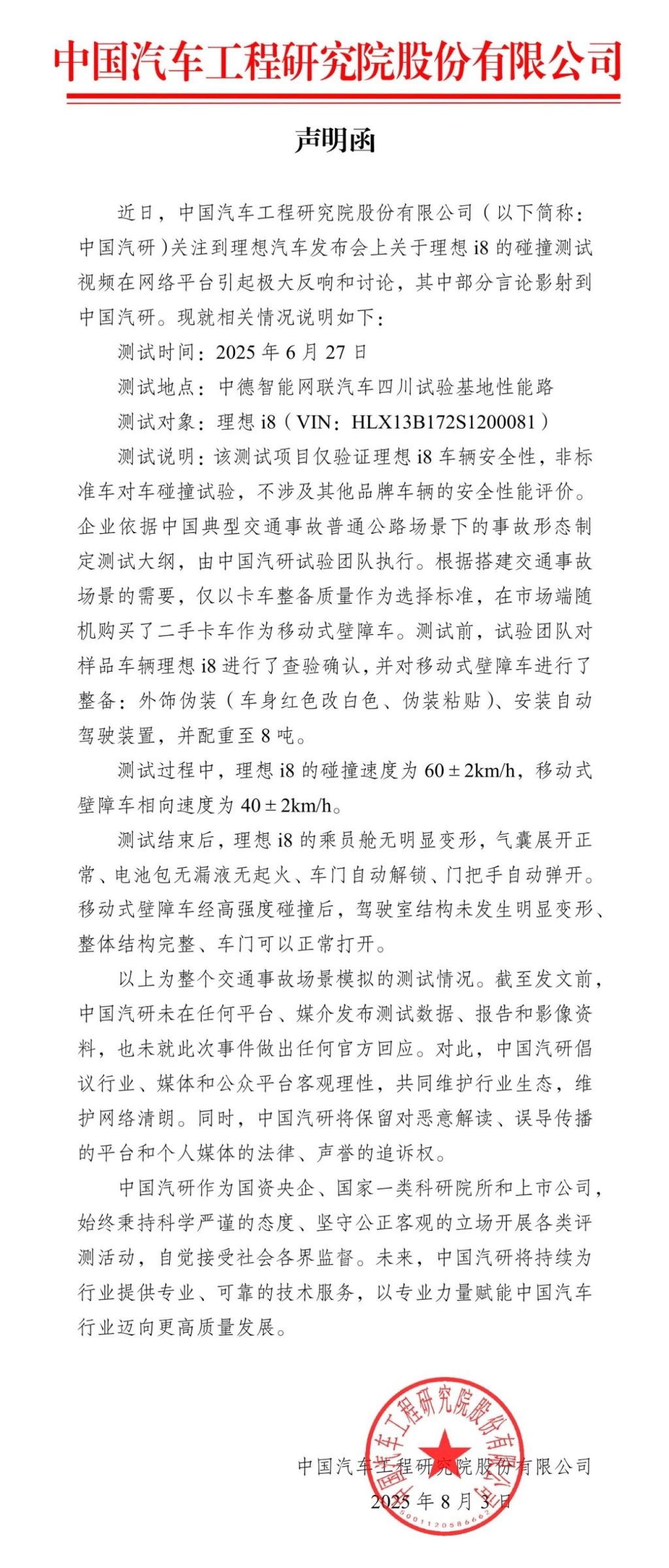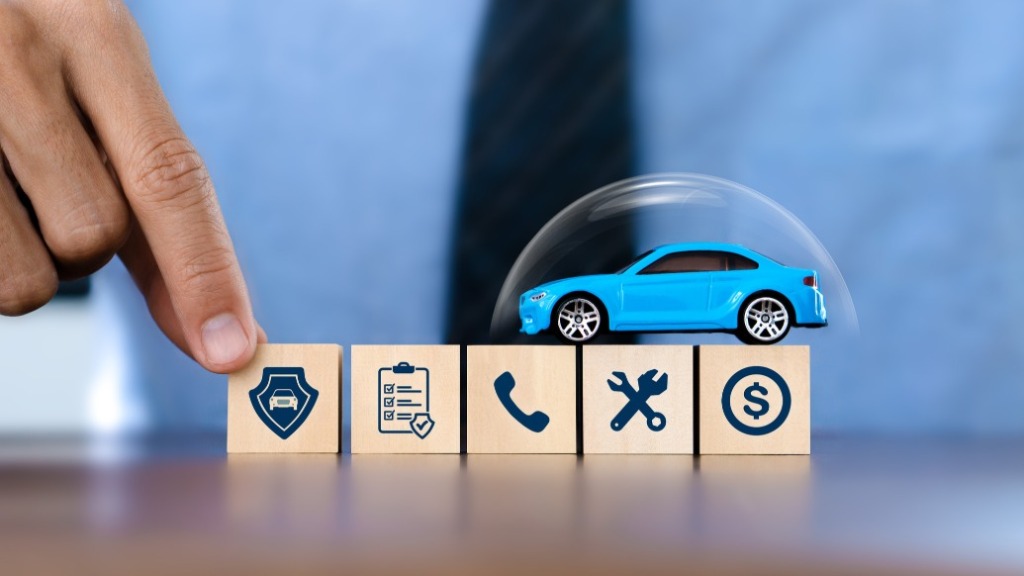
When an 8-ton heavy truck collided head-on with the Ideal i8 family SUV, the truck's wheels were lifted off the ground and the cab tilted forward - this collision test has been continuously questioned for its rationality.
Since the test video went online on July 29, Ideal Auto, Chenglong Truck, and China Automotive Research Institute have made multiple statements, emphasizing that the test was a non-standard vehicle-to-vehicle collision test and did not target the quality of truck brands.
As the controversy intensifies, a series of questions surface: What are the technical boundaries of crash testing? Has vehicle safety testing quietly become a publicity stunt for automakers and a business for testing agencies? How should consumers view the diverse array of car reviews?
All three parties have made public statements, but technical details remain to be clarified
On the evening of August 3, the China Automotive Research Institute issued a statement saying that the test project only verifies the safety of the Ideal i8 vehicle. It is a non-standard vehicle-to-vehicle collision test and does not involve the safety performance evaluation of other brands of vehicles.

Ideal Auto also stated that the truck was only used as a "mobile barrier" and that "we had no intention of, and did not, make any inductive evaluation of its quality. It was unintentional that the Dongfeng Liuzhou Motor Chenglong brand was accidentally involved in public opinion controversy during the testing process."

Prior to this, Chenglong Trucks had emphasized, "After our company's technical verification and professional evaluation, the test scenes and equipment in the video are significantly different from actual traffic conditions. We encourage everyone to view it rationally from a scientific perspective."
Industry insiders generally believe that the core controversy of the incident focuses on two points: the authenticity of the test scenario and the independence of the third-party testing agency.
In terms of technical details, firstly, the heavy-duty truck cab is designed with three independent mechanical locks. The probability of simultaneous unlocking during a collision is extremely low in engineering practice, which makes it suspected that the forward tilt of the cab that occurred in the test may have been caused by human intervention in the locking device. Secondly, the unloaded truck used in the test (the test screen shows that the total mass of the heavy-duty truck is 8 tons, which basically meets the unloaded weight of the heavy-duty truck) has a higher energy difference compared with the fully loaded conditions of 20 tons or even more that are common in actual accidents. The deviation of this operating condition setting from the actual road risks has become a focus of technical debate.

It is worth mentioning that China Automotive Research Institute (CARI) mentioned in its statement that "the company developed a test outline based on the accident forms of typical traffic accidents on ordinary highways in China, and the test outline was implemented by the CARI test team."
China Automotive Research Institute, the test executor, has sparked controversy with its business model of acting as both a judge and a waiter. When a testing agency's revenue is heavily dependent on automaker commissions, will its testing plans lean towards visually appealing scenarios to meet marketing needs?
According to the official website, China Automotive Research Institute was founded in March 1965 and was originally named Chongqing Heavy Duty Truck Research Institute. It is a national first-class scientific research institute, focusing on automotive technology research and development, testing and evaluation, quality inspection and industrial manufacturing.
According to the 2024 annual report of China Automotive Research Institute (601965), the company achieved operating revenue of 4.697 billion yuan last year, a year-on-year increase of 14.65%, and total profit of 1.14 billion yuan, a year-on-year increase of 14%. The largest contributor to this revenue came from the "Automotive Technical Services" business segment, which includes testing, with revenue of 4.125 billion yuan, a year-on-year increase of 21.36%, and a gross profit margin of nearly 50%. Specifically, revenue from the new energy and intelligent connected vehicle development and evaluation business increased by 42.86%, but the gross profit margin declined slightly to 47.61%.

"The automotive technical service business insists on being guided by market and customer needs, strengthening in-depth cooperation with key customers, and continuously expanding the business market; focusing on strategically advantageous main businesses and emerging businesses, actively improving the comprehensive technical service capabilities, and continuously optimizing product and business structures. Revenue in this period increased year-on-year." The annual report said.
In addition, there are media reports that the cost of a collision test by current automobile inspection agencies is as high as hundreds of thousands or even millions of yuan.
Industry insiders: Traditional crash tests are not absent, but they are "not eye-catching enough"
In fact, every new car must undergo a variety of tests before it is launched on the market, including collision tests required by mandatory national standards.
According to the "Administrative Measures for the Access of Road Motor Vehicle Manufacturers and Products" issued by the Ministry of Industry and Information Technology, every new vehicle must apply to the Ministry of Industry and Information Technology for road motor vehicle product access before it is launched. The application materials include inspection reports issued by inspection and testing institutions.
The State Administration of Quality Supervision, Inspection and Quarantine has also made detailed regulations regarding testing institutions through the "Measures for the Supervision and Administration of Motor Vehicle Safety Technical Inspection Institutions." Currently, testing institutions that meet these regulations include China Automotive Research Institute (Tianjin) Co., Ltd. and Shanghai Motor Vehicle Inspection and Certification Technology Research Center Co., Ltd.
An industry insider told the reporter from The Paper that every new car must go through the steps of "company-commissioned testing, agency report issuance, and technical review by the Ministry of Industry and Information Technology."
Before that, car companies will conduct thousands of tests on vehicles during the research and development stage, including collision tests, wind tunnel tests, durability tests, sealing tests, etc.
Third-party crash testing programs are also an option for many automakers. The China Automotive Technology and Research Center's (CATARC) C-NCAP and the China Insurance Research Institute's (CIASI) are generally considered more authoritative. C-NCAP, one of the nine global NCAP members, has government backing. CIASI, on the other hand, is backed by insurance companies with interests antagonistic to those of automakers. Its primary purpose is to mitigate claims fraud in vehicle accidents.
Since there are so many authoritative tests, why are there test scenarios where family cars overturn trucks?
"Testing should serve safety. But now the Chinese auto market is too competitive, and automakers need more impactful test scenarios and test results for publicity. These traditional, rigorous tests seem to be insufficient to attract consumers' attention." An industry insider told the reporter from The Paper.
China Automotive Research Institute (601965) also mentioned in its annual report that as a third-party automotive technical service organization with a long history, China Automotive Research Institute has formed an integrated service capability "from automotive development, testing, certification, evaluation, product promotion to after-sales" in recent years, effectively helping automakers solve pain points and difficulties in the product development process.
The annual report also introduced that China Automotive Research Institute has launched a series of third-party evaluations and formed a series of brands, "to help the company better develop the technical service market and better empower automobile companies' brands."
Car reviews have repeatedly sparked controversy, and the industry is calling on consumers to be rational.
In fact, controversies about car reviews occur from time to time.
In 2020, the "needle penetration test" of power batteries caused the two giants, BYD and CATL, to engage in multiple confrontations.
BYD released a video of a needle-puncture test on its "Blade Battery" to verify its safety performance under extreme conditions. However, CATL believes this is an abuse of the test scenario. Zeng Yuqun, chairman of CATL, stated, "Battery safety and battery abuse testing are two different things, but some people equate passing abuse testing with battery safety."
An insider in the automobile inspection industry told the reporter from The Paper that a typical case in the industry is the abuse of the "drill card test."
The "underpass" test is a specialized test within automotive safety testing designed to address the high-risk scenario of a passenger car under a truck. It verifies the effectiveness of a truck's rear-end protection systems. The test adheres to the national standard "GB-11567," which covers side and rear underbody protection systems, not the structural safety of a typical passenger car underfoot.

However, in recent years, the drill-and-trap test has been used by many automakers and related parties to evaluate the safety performance of passenger car A-pillars and other structures. Industry insiders believe this is a form of abuse. "It may appear to be a common scenario, but it obscures the primary objective: the protective devices of the truck being struck. This distracting 'stunt' doesn't truly prove the safety of passenger vehicles."
Several industry insiders told The Paper that vehicle testing is a matter of safety and that consumers should approach it rationally. Some even bluntly stated that the sheer variety of testing methods could mislead consumers, and expressed hope that regulators would "throw cold water on this business."
However, some industry insiders have suggested that companies must successfully pass the "mandatory" regulatory requirements to qualify for listing. Crash tests like the one conducted by the Ideal i8 can be understood as "optional" vehicle safety tests. "A paper-based test is also about safety, as long as the company doesn't engage in false advertising."


